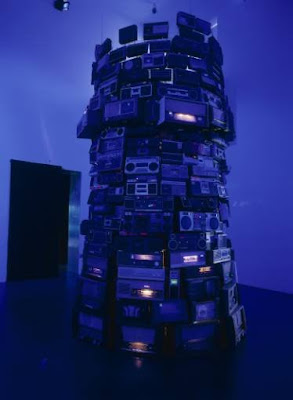His most substantial prose work is the surrealist novel 'Mort aux Vaches et au champ d'honneur' - literally 'Death to the Cows and to the Field of Honour' but sometimes translated as Death to the Pigs (since Vaches was used as slang for cops).
To give one example of its striking imagery, it features a section where the sobs of cinema goers form a sea of tears that floods the world:
'Suddenly the sun yawned like a dog waking up, and breath reeking of garlic polluted the atmosphere. A kazoo came and fell in to the heap of barbed wire the broom-seller was tangled in. He grabbed it and blew into it. A long whine and several tears emerged, which burst and expelled lumps of foam all around, which floated on the sea of tears. Delighted, the broomseller continued to blow into the kazoo, continuing to to produce teary fireworks which burst into foam and settled all about him... When the sea of tears was covered over with a thick rug of foam, circumstances changed rapidly for the broom-seller, who had the unfortunate notion of lying down on it. Barely had he stretched out when the kazoo's whimpering became extraordinarily loud. They were no longer whimpers but veritable roars which destroyed his eardrums and slowly dug a tunnel through his head'
Like other Surrealists, Péret used automatic writing as a technique to discover the marvelous in everyday life: 'The marvelous, I say again, is all around, at every time and in every age. It is, or should be, life itself, as long as that life is not made deliberately sordid as this society does so cleverly with its schools, religion, law courts, wars, occupations and liberations, concentration camps and horrible material and mental poverty'.
His experiences in the French army in the First World War made him a pronounced anti-militarist, as well as being vehemently anti-clerical - Mortes Aux Vaches includes images of 'A general trampled by reindeer' and dogs sniffing dead priests. The photograph here was originally published in La Révolution surréaliste (1926) with the caption 'Our colleague Benjamin Péret in the act of insulting a priest'.
Péret was one of the first of the Surrealists to break with Stalinism. In the early 1930s, living in Brazil (with his wife, the singer Elsie Houston) he joined the trotskyist Communist League. In the Spanish Civil War, he worked first with the independent socialist POUM and then an anarchist militia fighting on the Aragon front. Later he was part of a group called the Union Ouvriere Internationale which broke with the trotskyist movement over the latter's defence of the Soviet Union as a degenerate workers state (see this biography of Ngo Van Xuhat for more about this)
In a 1949 poem, A Lifetime, Péret looked back on his long association with Andre Breton and wrote of:
'the songs in raised fists of the eternal rebels thirsting for ever new wind
for whom freedom lives as an avalanche ravaging the vipers' nests of heaven and earth
the ones who shout their lungs out as they bury Pompeiis
Drop everything'.
Main source: Benjamin Péret, Death to the Pigs and Other Writings, translated by Rachel Stella and others (London: Atlas Press, 1988). The best source online is L'Association des amis de Benjamin Péret (in French)






 Both balls employed private stewards to maintain "order" and exclude "undesirables." From 1933, having failed to secure a police presence, Malcolm employed two ex-CID officers to remove any identifiable "sexual perverts." From 1935 tickets were sold with the proviso that "NO MAN IMPERSONATING A WOMAN AND NO PERSON UNSUITABLY ATTIRED WILL BE ADMITTED". On entry, men's costumes had to be approved by a "Board of Scrutineers." Whatever they tried, however, the organizers could neither keep the "Degenerate Boys" out nor adequately contain their visibility; indeed, they often struggled even to identify them amidst the fancy dressed crowds. In 1938, an observer thus described the "extraordinary number of undesirable men at this Ball who were unmistakably of the Homo-Sexual and male prostitute types." Well into the 1950s, the balls remained, in Stephen's words, "a great Mecca for the gay world."
Both balls employed private stewards to maintain "order" and exclude "undesirables." From 1933, having failed to secure a police presence, Malcolm employed two ex-CID officers to remove any identifiable "sexual perverts." From 1935 tickets were sold with the proviso that "NO MAN IMPERSONATING A WOMAN AND NO PERSON UNSUITABLY ATTIRED WILL BE ADMITTED". On entry, men's costumes had to be approved by a "Board of Scrutineers." Whatever they tried, however, the organizers could neither keep the "Degenerate Boys" out nor adequately contain their visibility; indeed, they often struggled even to identify them amidst the fancy dressed crowds. In 1938, an observer thus described the "extraordinary number of undesirable men at this Ball who were unmistakably of the Homo-Sexual and male prostitute types." Well into the 1950s, the balls remained, in Stephen's words, "a great Mecca for the gay world."









